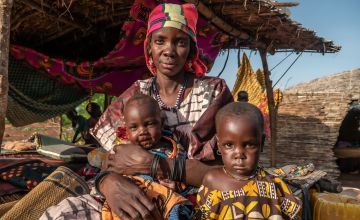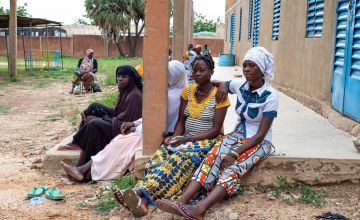
Knowledge Hub
Since 2021, Concern has been responding to a multifaceted humanitarian crisis in the western African country of Burkina Faso. Learn more about what’s going on.
A landlocked country in western Africa that’s home to 21.5 million, Burkina Faso is the site of a growing crisis that has gone largely underreported in our media. Political marginalization, the effects of the climate crisis, and conflict have combined to form an unprecedented humanitarian emergency in a country that, until recently, was most concerned with chronic hunger and malnutrition. This is also one of the reasons that Concern began working in Burkina Faso at the beginning of 2021.
What led to conditions becoming so severe? Read on for five key points about Burkina Faso’s humanitarian crisis — and to learn about how Concern is working with communities to offset the scope and impact of this humanitarian emergency.
The Burkina Faso crisis by the numbers:
- 3.5 million people in Burkina Faso require humanitarian assistance, representing a 60% increase in the last year.
- Over 1.2 million Burkinabés have been displaced by conflict, making Burkina Faso the fastest-growing displacement crisis in recent times.
- 80% of all internally-displaced Burkinabés are women and children.
- At 8.8%, Burkina Faso has one of the highest child mortality rates in the world
- Over 14% of Burkinabés are undernourished.
- Among children under 5, 8.1% of Burkinabés suffer from acute malnutrition, while 23.8% suffer stunting.
- UN estimates suggest that harvests have, on average, decreased by 50% in northern Burkina Faso due to climate events. In some areas, that figure is as high as 80%.
1. Conflict in Burkina Faso has escalated sharply since 2019
Burkina Faso has faced conflict and insecurity since 2015, but the situation began to take a turn for the worse beginning in 2018. Since 2019, the security situation in the country’s northern and eastern regions has swiftly deteriorated causing the country to experience the greatest decline in peace from 2020 to 2021, according to this year’s Global Peace Index. Between 2019 and 2021, the number of incidents related to insecurity has more than tripled, rising from 211 in 2019 to 720 in just the first eight months of 2021.
Conflict has displaced more than 1.2 million people in just two years, making Burkina Faso the fastest-growing displacement crisis in recent times. More broadly, one-fifth of the country’s population, or 3.5 million Burkinabés, require humanitarian assistance. This represents a 60% increase in humanitarian need between January 2020 and January 2021. Unfortunately, the violence shows no sign of stopping, which means that displacement and need are only expected to increase in 2022.

2. Conflict-driven displacement has created a domino effect
The increase in internally-displaced Burkinabés has impacted neighbouring areas. Some host communities have nearly doubled in population as they accommodate their compatriots driven from home by conflict. Most of those who have been forced to flee lost their incomes in the process, abandoning farms and livestock. Displacements have an especially harsh effect on women, children, the elderly, people living with disabilities, and other marginalised groups. Women and children represent 80% of those internally displaced in Burkina Faso, and they are especially vulnerable to violence at this time.
Host communities also feel the impacts of these population increases, which could be temporary or, depending on the nature of this conflict in the long run, more protracted. Currently, local infrastructure is struggling to keep up with demands for healthcare, clean water, and adequate sanitation services. In some instances, conflict has caused host community health centres to shut down due to a lack of resources, which is especially challenging during a global pandemic.
3. Up to 90% of Burkinabés rely on agriculture, meaning that they are especially vulnerable to the climate crisis
Approximately 80 to 90% of Burkinabés make their livelihoods on rain-fed agriculture, meaning that the country is especially vulnerable to the impact of climate shocks. An increasing average temperature and decreasing periods of rain are testing the resilience of the majority of the country’s population, particularly in the northern Sahelian area. By 2050, the United Nations predicts a 10% decrease in already-precious rainfall, and a median temperature increase of 1.4 to 1.6° Celsius. This could be a potentially deadly combination, resulting not only in more frequent droughts, but also bush and forest fires.
In 2021, inconsistent rainfall and drought combined with Burkina Faso’s security crisis to reduce harvest yields and limit access to clean water and adequate sanitation and hygiene facilities, both of which threaten the health and nutrition of millions.
4. Clean water is also a chief concern, and affected by this crisis

Conflict, displacement, and poor rainfall have all combined to make water, sanitation, and hygiene all key concerns for Burkina Faso in 2022. Oxfam estimates that water access has dropped by 40% in some areas of the country.
A lack of infrastructure to support current demands in many areas has led to an increase in water-borne illnesses, as well as increased vulnerability for women and girls — who are often tasked with collecting water and face the threats of attacks and violence along the way.
5. All of these combined have also led to a growing food crisis in Burkina Faso
Increasing violence, displacement, and climate events (alongside health crises like Covid-19) have resulted in rising hunger rates in Burkina Faso, with 3.3 million people facing a food crisis. As a response to this growing food insecurity, many Burkinabés have turned to negative coping mechanisms, like reducing the number of meals they consume each day and moving towards less nutrient-rich food. 24.9% of children under 5 years old in Burkina Faso are currently stunted (low height for weight). In the 2021 Global Hunger Index, Burkina Faso ranks 91st out of the 116 countries with sufficient data to calculate 2021 GHI scores, making it the 25th hungriest country on earth.
For provinces in the country are facing critical conditions that, according to the Integrated Food Security Phase Classification (IPC) are one step away from famine-like conditions.
Concern in Burkina Faso: Our first year

Following an assessment in 2020, Concern entered Burkina Faso in January 2021. Our initial response is to the rapidly-evolving humanitarian crisis in the country, as well as the largest-growing displacement crisis in Africa. Our Emergency Response programme, in partnership with Alliance2015 members, is designed to improve access to essential, quality health and nutrition services that are able to adapt to the evolving nature of this crisis.
In our first year, we have provided 500 families, both members of the internally-displaced and host communities, with unconditional, multi-purpose cash transfers combined with hygiene campaigns. We’ve also worked with 200 additional families on a cash-for-work program that improves livelihoods as well as local sanitation infrastructure.
In terms of water, sanitation, and hygiene, we’ve also distributed hygiene and dignity kits to recently-displaced IDPs and both rehabilitated infrastructure within and provided key medical supplies to local health centres. Nutrition is another key element of our work in Burkina Faso, with a focus on tailoring services to work in insecure and hard-to-reach areas. We remain dedicated to ensuring that infants, young children, and pregnant and breastfeeding mothers all have the support they need to remain healthy and secure.
Other ways to help
Donate now
Give a one-off, or a monthly, donation today.
Join an event
From mountain trekking to marathon running, join us for one of our many exciting outdoor events!
Buy a gift
With an extensive range of alternative gifts, we have something to suit everybody.
Leave a gift in your will
Leave the world a better place with a life-changing legacy.
Become a corporate supporter
We partner with a range of organisations that share our passion and the results have been fantastic.
Create your own fundraising event
Raise money for Concern by organising your own charity fundraising event.





